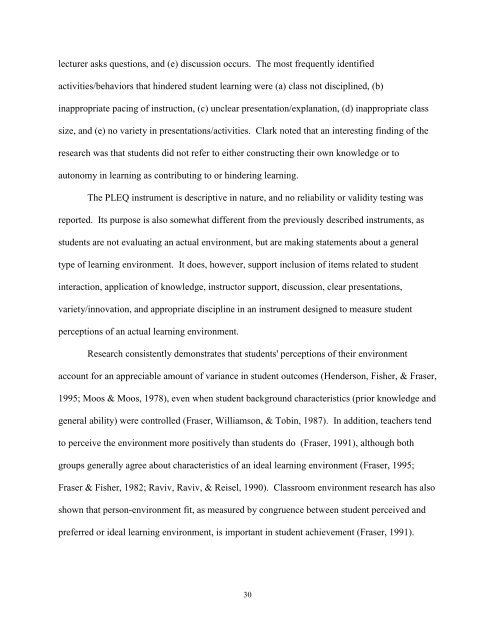STUDENT EVALUATION OF CLINICAL EDUCATION ENVIRONMENT
STUDENT EVALUATION OF CLINICAL EDUCATION ENVIRONMENT
STUDENT EVALUATION OF CLINICAL EDUCATION ENVIRONMENT
Create successful ePaper yourself
Turn your PDF publications into a flip-book with our unique Google optimized e-Paper software.
lecturer asks questions, and (e) discussion occurs. The most frequently identified<br />
activities/behaviors that hindered student learning were (a) class not disciplined, (b)<br />
inappropriate pacing of instruction, (c) unclear presentation/explanation, (d) inappropriate class<br />
size, and (e) no variety in presentations/activities. Clark noted that an interesting finding of the<br />
research was that students did not refer to either constructing their own knowledge or to<br />
autonomy in learning as contributing to or hindering learning.<br />
The PLEQ instrument is descriptive in nature, and no reliability or validity testing was<br />
reported. Its purpose is also somewhat different from the previously described instruments, as<br />
students are not evaluating an actual environment, but are making statements about a general<br />
type of learning environment. It does, however, support inclusion of items related to student<br />
interaction, application of knowledge, instructor support, discussion, clear presentations,<br />
variety/innovation, and appropriate discipline in an instrument designed to measure student<br />
perceptions of an actual learning environment.<br />
Research consistently demonstrates that students' perceptions of their environment<br />
account for an appreciable amount of variance in student outcomes (Henderson, Fisher, & Fraser,<br />
1995; Moos & Moos, 1978), even when student background characteristics (prior knowledge and<br />
general ability) were controlled (Fraser, Williamson, & Tobin, 1987). In addition, teachers tend<br />
to perceive the environment more positively than students do (Fraser, 1991), although both<br />
groups generally agree about characteristics of an ideal learning environment (Fraser, 1995;<br />
Fraser & Fisher, 1982; Raviv, Raviv, & Reisel, 1990). Classroom environment research has also<br />
shown that person-environment fit, as measured by congruence between student perceived and<br />
preferred or ideal learning environment, is important in student achievement (Fraser, 1991).<br />
30












